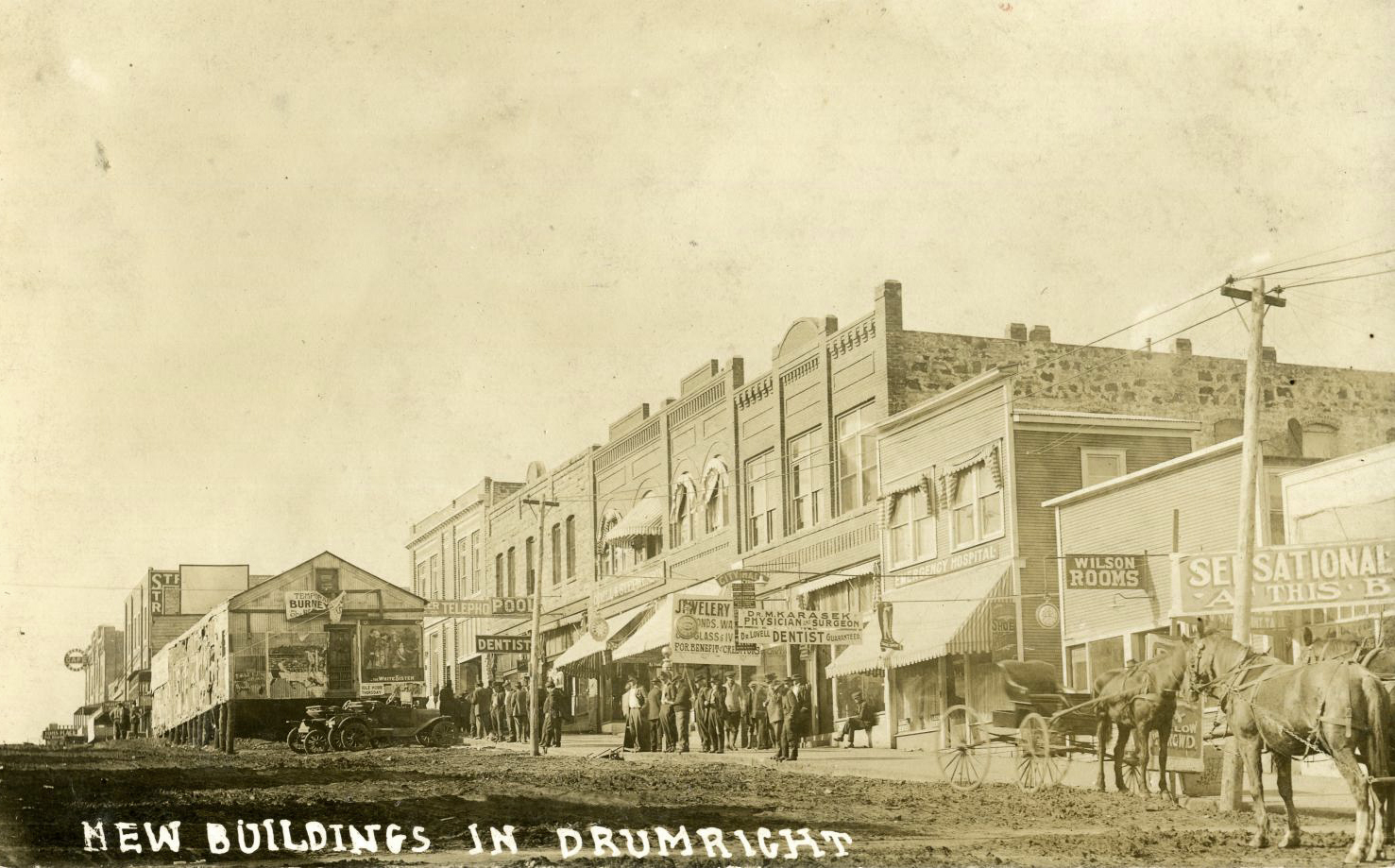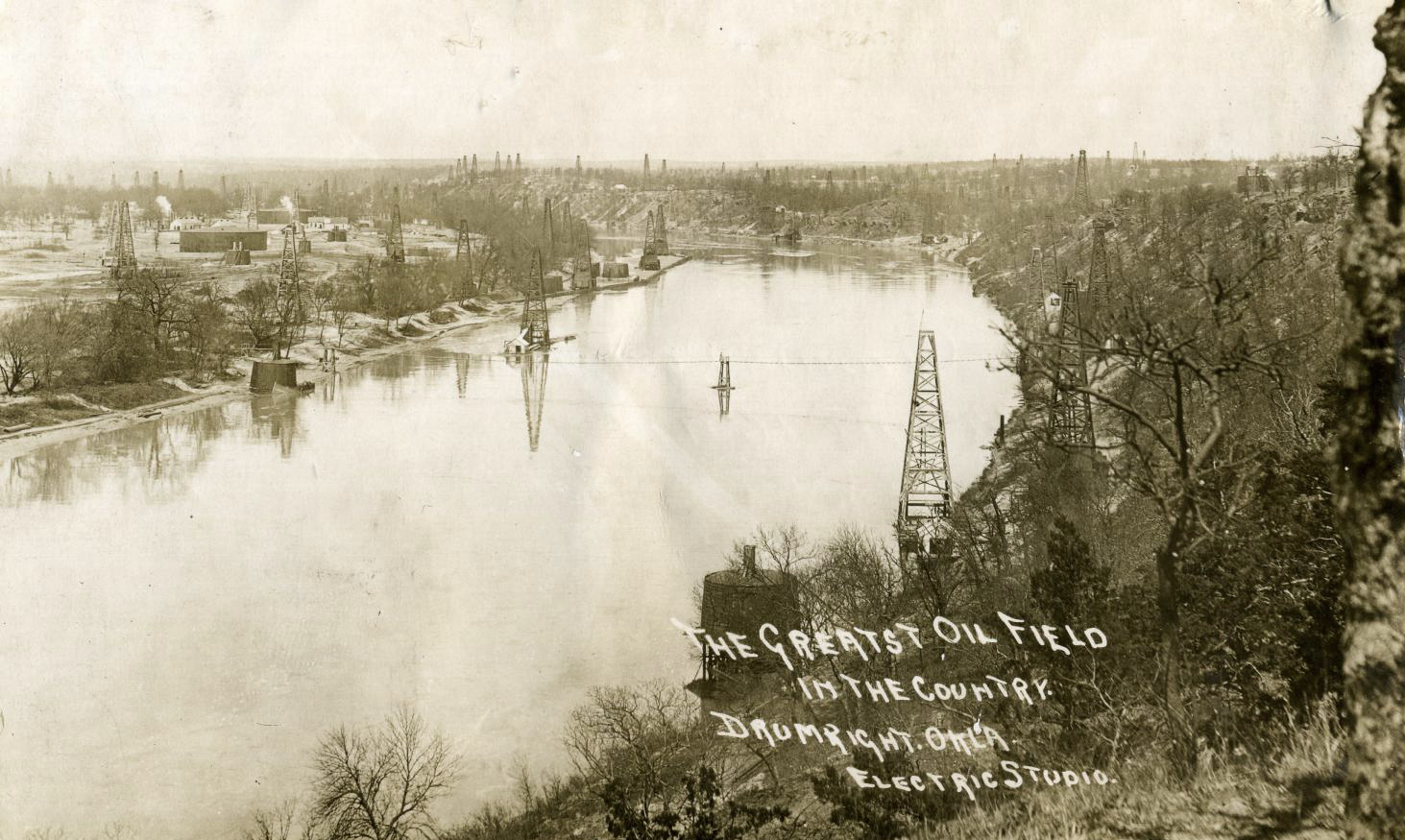
DRUMRIGHT.
Located in northwestern Creek County, Drumright is situated at the intersection of State Highways 16, 33, and 99. Twenty-six miles west of the county seat of Sapulpa, the community developed as an oil-boom town with a post office, established there on December 28, 1912. On January 28, 1913, local landowners James W. Fulkerson and Aaron Drumright decided to plat a townsite. Locally called Fulkerson, the town was renamed Drumright in 1913 for Aaron Drumright.
The first producing well in the Cushing-Drumright Field, the Wheeler Number One, was completed in March 1912. The rapid influx of oil-field workers to Drumright lived in tents and boxcar shacks. Consequently, the area was locally known as Ragtown. Rooming houses and hotels were eventually erected. Typical of the early boomtowns, gambling dens, dance halls, and roadhouses soon proliferated. To accommodate the shipment of additional freight between boomtowns, the Oil Fields and Santa Fe Railway (later the Atchison, Topeka and Santa Fe Railway, AT&SF) constructed a line in 1915 from Frey Junction (south of Oilton) to Drumright. In 1930 the St. Louis and San Francisco Railway (SL&SF) completed a line from Shamrock to Drumright.
On May 27, 1913, citizens voted in favor of incorporating the town. Three years later the population within the city limits exceeded two thousand. They held an election on April 18, 1916, to become a city of the first class. In earlier years one-room schoolhouses known as Dry Hill and Tiger provided children with an education. In October 1914 a two-story, stone building opened as an elementary and high school called Washington School (listed in the National Register of Historic Places, NR 81000462). The Tidal School (NR 81000461) opened in 1930 to accommodate the children of the numerous oil company workers. In 1914 two banks opened, the Drumright State Bank, with Aaron Drumright as president, and the First National Bank, organized by Ned Holeman of Guthrie. Early newspapers included the Drumright Derrick and the Drumright News. Syrian-Lebanese merchants established dry goods and grocery stores. As early as March 1913 the Massad Brothers advertised their dry goods establishment in the Drumright Derrick newspaper. The First United Methodist Church of Drumright (NR 82003679) was among the first churches to organize. Others included Baptist, Presbyterian, Christian, Catholic, Congregational, and Dunkard.
Drumright has been plagued by numerous disasters. In August 1914 an oil-field fire destroyed several gas wells. Another fire destroyed the supposedly fireproof Morrow Hotel on October 8, 1915. In June 1917 strong winds damaged oil derricks and workers' tents. On April 2, 1956, and June 8, 1974, tornadoes caused deaths and extensive property loss.
During the 1920s and 1930s entertainment abounded. Popular sporting events included boxing matches and baseball games. Residents listened to the music of Bob Wills and his Texas Playboys, broadcast over KVOO radio station, and danced to his music when he came to Drumright once a month. Through a Works Progress Administration (WPA) project, a municipal swimming pool opened in 1940. Other town amenities during the 1940s included two city parks, a ballpark, a golf course, a public library, and a hospital.
In the 1930s Drumright's economy remained primarily based on the oil and gas industry. Only two cotton gins and one grain mill operated. A minor oil boom that occurred during the 1970s and 1980s created jobs. At that time two manufacturing firms, Latoka Engineering and Thermoflux, also provided employment. The Central Technology Center, opened on August 22, 1970, employed approximately 125.
During the early boom years Drumright had an estimated population of fifteen thousand. The first federal census reported 6,460 residents in 1920. Numbers dropped in 1930 and 1940 to 4,972 and 4,303, respectively. Population rose to 5,028 in 1950, only to decline to 4,029 in 1960. The lowest point occurred in 1970 at 2,740. In 1980 and 1990, 3,278 and 2,799 individuals were counted.
With 2,905 living there at the turn of the twenty-first century, Drumright had a council-manager form of government. In 2010 the population remained stable at 2,907. Residents supported two school districts, Drumright and Olive, as well as a weekly newspaper, the Drumright Gusher. Annual events included wine festivals and the Oil Patch Jamboree. The Wheeler Number One Oil Well Site (NR 83002083), the Barnett Jackson Number 11 Oil Well Site (NR 82003681), and the Drumright Gasoline Plant Number 2 (NR 82003677) were listed in the National Register of Historic Places. The Santa Fe Depot, also known as the Drumright Oil Museum (NR 81000460), houses oil industry artifacts and features the town's early history. The Aaron Drumright House (NR 82003678) and the J. W. Fulkerson House (NR 83003680) were added to the National Register of Historic Places in 1982 and 1983, respectively. Everett Francis Drumright (1906–93), born in Drumright and son of Aaron Drumright, served in various U.S. Department of State positions, including ambassador to China in the 1950s. In April 2020 the census reported 2,562 residents.








